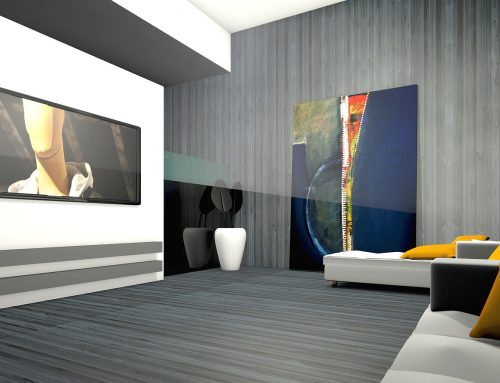Wie Sie ihren 2D- und 3D-Workflow mit Cineware kombinieren können.
Cineware ist ein neues Plugin, der das Compositing– und Motion-Graphics-Paket von Adobe After Effects und die 3D-Software Cinema 4D verbindet. In dem folgenden Beitrag geben wir ihnen einige Tipps, die ihnen helfen werden, Cineware in ihren Workflow zu integrieren.

Für viele Designkünstler ist es ein Traum, 3D- und 2D-Anwendungen gemeinsam in einem Projekt zu nutzen. Bis vor Kurzem bestand der 3D/2D-Workflow aus der Erstellung ihrer 3D-Animation, dem Einrichten ihrer Render Passes und dem Rendern. Es gab eine zusätzliche Option, in dem Sie beim Öffnen ihres fertigen Renderers in ihrer Compositing-Anwendung den Prozess aufgrund eines Kundenwechsels nicht wiederholen mussten.
Softwareentwickler sind sich dieses Problems bewusst und beginnen, neue Software zu entwickeln, um 3D- und 2D-Anwendungen zu verbinden. Einer der ersten Blöcke heißt Cineware, das Teil von After Effects CC ist.
Mit Cineware können Sie 3D-Dateien direkt in After-Effects-Kompositionen importieren, als wären sie eine andere native After-Effects-Layer. Cineware funktioniert am besten mit Cinema 4D-Dateien (daher der Name), wo es eine Menge an Integration bieten kann, einschließlich der Arbeit mit Cinema 4D-Kameras, Lichtern und Layerkontrollen.
Um diesen neuen Workflow optimal zu nutzen, wird After Effects mit Cinema 4D Lite geliefert, mit dem Sie grundlegende 3D-Elemente erstellen und sich auch an den Cinema 4D-Workflow gewöhnen können, wenn Sie auf eine vollwertige Version von Cinema 4D umsteigen möchten.
Mit der Einführung von Cineware ist es an der Zeit, ihrer After-Effects-Arbeit eine weitere Dimension zu verleihen.
Erste Schitte.
Um Cineware in After Effects zu starten, müssen Sie zunächst eine Cinema 4D-Datei erstellen, anstatt die normale Methode zum Anwenden eines Plugins auf einen Layer in einer Komposition zu verwenden. Gehen Sie zu Datei > Neue Maxon Cinema 4D Datei. Dies wird zwei Dinge bewirken.
Zuerst (nachdem Sie sich entschieden haben, woe Sie ihre neue Datei speichern möchten) startet After Effects die aktuellste Version von Cinema 4D, die Sie auf ihrem Computer haben, mit dem kleinsten gemeinsamen Nenner, der eigenen Version von After Effects, Cinema 4D Lite. Zudem wird in ihrer Komposition ein neuer Layer mit der Bezeichnung ihrer neuen Cinema 4D-Datei erscheinen.
Wenn Sie bereits eine Cinema 4D-Datei haben, die Sie in After Effects integrieren möchten, ziehen Sie diese einfach in ihr Kompositions- oder Projektfenster in After Effects.
Nächste Schritte.
Jetzt haben Sie ihre Cinema 4D-Datei in After Effects live über Cineware verknüpft. Was Sie alles tun können, hängt nun von der Version von Cinema 4D ab, die Sie verwenden.
Cinema 4D gibt es in fünf verschiedenen Versionen, darunter After Effects Cinema 4D Lite, Sie können einen Vergleich der Funktionen sehen, die Sie auf der MAXON-Website erhalten, mit einer Preisspanne von günstig bis alamierend für die Vollversion von Studio.
Denken Sie jedoch nicht, dass Sie eine Kopie von Cinema 4D kaufen müssen, um Cineware zu verwenden. Sie können 3D-Assets in jeder beliebigen 3D-Software erstellen, einschließlich der Open-Source-3D-Anwendung Blender und Cinema 4D Lite, die zum Importieren verfügbar sein sollte.
Die 3D-Modelldateien, die Cinema 4D Lite importieren kann, sind DXF, DWG, 3DS, DAE, FBX, DEM, LWS, STL, VRML2, OBJ, COLLADA und Alembic.
Vergessen Sie auch nicht die Modellierungswerkzeuge, die in Cinema 4D Lite verfügbar sind. Es gibt einige Grafikanimationswerkzeuge, die das diskussionswürdige Fracture Object und die dazugehörigen Mograph-Effektoren, die nur in den teureren Versionen von Cinema 4D (Broadcast und Studio) erhältlich sind, die ihnen bei der Erstellung von 3D-Motion Graphics sehr helfen können.
Schnellerer Workflow.
Eines der Hauptprobleme, die die Leute bei Cineware haben, ist, dass es vergleichsweise langsam ist, wenn Sie es verwenden, um ihre Cinema 4D-Modelle einfach zu importieren und zu verwenden.
Dadurch entgehen ihnen viele Vorteile, die ihnen ein geeignetes 3D-Animationssystem in Verbindung mit After Effects bieten kann.
Ein Beispiel dafür, wie Sie mit Cineware ihren Workflow verbessern können, ist das Ausblenden einer After Effects Animation in Cinema 4D mit Kameras, Lichtern und Dummy-Objekten in Cinema 4D Lite. Die 3D-Kamera-Tools in After Effects sind eine Aufgabe, die es zu animieren gilt, im Vergleich zur Erstellung einer gleichwertigen Animation in Cinema 4D.
Sie können AE-Nulls in Cinema 4D Lite erstellen, indem Sie das „External Compositing Tag“ verwenden und auf Solid ankreuzen. Wenn Sie wieder in After Effects sind, klicken Sie auf „Extrahieren“ im Cineware-Effektfenster, um ihre animierten Kameras zusammen mit den AE-Nulls einzubringen. Die funktioniert auch bei Leuchten. Alternativ können Sie ihre After-Effects-Kamera über den Button „Zusammenführen“ im Cineware-Effektfenster an Cinema 4D senden.
Layers und Mattes.
Ein weiterer Bereich, in dem Cineware nützlich sein kann, ist die Verwendung von Layern und Mattes aus Cinema 4D, um darüber nachzudenken, wie Sie ihre endgültige Aufnahme zusammensetzen werden. Ein Vorteil von Cineware ist die Möglichkeit, die Namen der Objektpuffer aus Cinema 4D zu übernehmen.
Objektpuffer sind die Mattschichten von Cinema 4D und können mit separaten Modellen und Objektgruppen in Cinema 4D verknüpft werden.
Objektpuffer sind Teil des Cinema 4D Multipass-Rendering-Ausgabesystems und können auch in Cineware betrachtet werden. Beispielsweise können Sie einen Cineware-After-Effects-Layer mit nur den Reflexionen auf einem Objekt in ihrer Szene verwenden, die unscharf sein können.
Layer in Cinema 4D können die Sichtbarkeit von Objekten in Cinema 4D und damit auch in Cineware steuern. Sie können wählen, ob Sie Objekte nur in der Bearbeitungsansicht von Cinema 4D Lite mit Layern sehen möchten und nicht mit Rendern. Dies kann hilfreich sein, wenn Sie Referenzobjekte verwenden müssen, um mit denen Sie modellieren können oder als Quelle für ein geklontes Bewegungsgrafikelement.
Die richtige Wahl?
Wir müssen beachten, dass Cineware sein Hauptziel, eine nahtlose Verbindung zwischen After Effects und Cinema 4D zu gewährleisten, nicht ganz erreicht. Möglicherweise ist ihr vorhandener Arbeitsablauf beim Modellieren und Rendern in Cinema 4D immer noch schneller als wenn Sie sich nur auf Cineware verlassen, was sich verlangsamen kann, insbesondere wenn Sie die fortgeschritteneren Rendereinstellungen und Materialien von Cinema 4D verwenden.
Es gibt zwar After Effects Plugins, die die Verlangsamung mildern können. Uns gefällt die Tatsache, dass Cineware neue Möglichkeiten bietet, 3D in After Effects zu integrieren und mit 3D zu arbeiten. Zum Beispiel ist es eine ausgezeichnete Möglichkeit, Lichter zu animieren, die für Leuchtkugeln mit fertigen Renderings von Cinema 4D verwendet werden können.
Vielen Dank für ihren Besuch.


